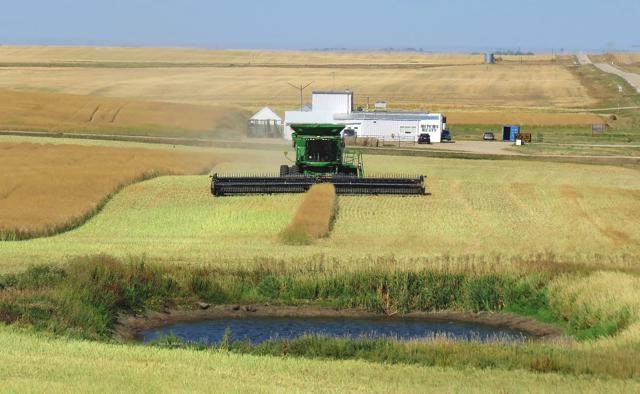Producers have made significant harvest progress, due in large part to the warm and dry weather, Saskatchewan Agriculture reported for the week ending September 11. Producers have now combined 65 per cent of the crop and 22 per cent of the crop is swathed or ready to straight-cut. This figure is well ahead of the 45 per cent completed in the previous reporting week and ahead of the five-year average and ten-year average of 40 per cent combined for this time of year. One year ago, the surplus topsoil moisture and frequent rainfall delayed harvest progress for much of the province. Only 38 per cent of the crop had been combined and downgrading was common due to disease and weathering. Two years ago, only 23 per cent of crops had been harvested by this time.
Harvest is most advanced in the southwestern region, where 86 per cent of the crop is now combined. The southeastern region has 76 per cent combined, the west-central region 66 per cent and the east-central region 57 per cent. The northeastern region has 37 per cent combined, while the northwestern region has 35 per cent combined. Some producers have wrapped up harvest operations and many more expect to be finished in the coming weeks.
Provincially, according to crop, 99 per cent of winter wheat, 98 per cent of fall rye, 98 per cent of lentils, 95 per cent of field peas, 82 per cent of mustard, 81 per cent of durum, 74 per cent of chickpeas, 71 per cent of barley, and 63 per cent of spring wheat are now in the bin. The harvesting of some crops is slower with 50 per cent of canola, 49 per cent of canaryseed, 48 per cent of oats, 20 per cent of flax, and 10 per cent of soybeans now combined, while 39 per cent of canola has been swathed or is ready to straight-cut.
Durum grades are being reported as 69 per cent 1 CWAD, 28 per cent 2 CWAD and three per cent 3 CWAD. Pea grades are 47 per cent 1 CAN, 49 per cent 2 CAN and four per cent 3 CAN. Lentil grades are 37 per cent 1 CAN, 57 per cent 2 CAN, five per cent 3 CAN and one per cent Sample Grade.
Minimal disease issues have occurred so far, although there are some lighter bushel weights being reported.
The majority of the province received no rainfall last week, although the Unity and Neilburg areas both reported receiving 5 mm. Topsoil moisture conditions continue to worsen with the warm and windy weather. Across the province, topsoil moisture on cropland is rated as 15 per cent adequate, 39 per cent short and 46 per cent very short. Hay land and pasture topsoil moisture is rated as 11 per cent adequate, 34 per cent short and 55 per cent very short.
With the dry field conditions, many producers have indicated that winter cereals may not be seeded this fall. Lack of moisture continues to cause crop damage, while strong winds have blown swaths around and shelled-out standing crops. There are many reports of combine and grass fires due to the extremely dry conditions. Some areas in the north reported frost and producers are assessing damage.




